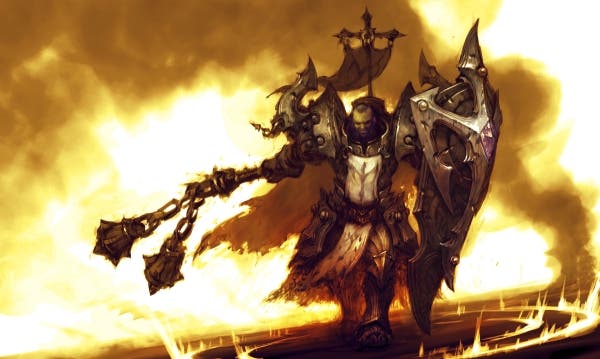Diablo 3 Crusader tips - stats, best Follower, class gems, gearing, Paragon guide
Our essential guide to the new Crusader class, from choosing the right Follower, to socketing in the best gems, and getting ready for Torment.
Released earlier this year for owners of the Reaper of Souls expansion, the Crusader is Diablo 3's new melee class - one which looks to holy spells to help rain unholy hell down upon its enemies. If you've chosen the magical mace-swinging path, here's some useful advice to help you level up and prepare for end-game gear farming.
How to level a Crusader
Your most important stat as a Crusader is Strength, so look for items that give you a big dollop of it as you upgrade your equipment. Put a Ruby in your Head slot so you get plenty of extra experience points with every kill, and a Ruby in your weapon. If you lack sockets in these items, pay a visit to the Mystic, or just wait for a lucky drop.
Don't forget to inch the difficulty setting up as you become more and more powerful. You'll receive more experience for taking on a stiffer challenge, and you can use those Treasure Goblins as a good barometer for seeing how fighting fit you are. If they portal away before you can kill them, it's probably worth dropping down a difficulty level.
If you're struggling to put your own build together, take a look through the levelling builds curated by the team at Noxxic.com.
The right Follower for a Crusader
Certainly as you work your way through the rather serene challenge of levelling to 70, it makes sense to pick a Follower who benefits from the same primary stat as your Crusader. That way you can equip your new friend using hand-me-down equipment that's no longer needed by your hero. For this reason, we recommend the Templar, thanks to his preference for the Crusader's Strength stat. If you're playing in Hardcore mode, you'll also appreciate the extra survival spells your team-mate brings to the table.
Gearing up for Torment farming
If you've got a few Blood Shards saved up, it's worth hitting up the Gambler to try and get lucky on some nice early Rare items. Ideally you're looking for three sockets on your Chest piece and two sockets on your Legs, so you can stuff them to the brim with Strength-boosting Rubies.
If you're short of Blood Shards, start farming Bounties and Rifts for both gear and gambling opportunities. If you've unlocked the Plans at the Blacksmith, you might want to look into crafting some items from the Aughild's and Captain Crimsons sets - they're excellent value for money and will help you out for some time.
As you work your way towards Torment difficulty, you want to make sure you're fleshing out some core stats across your equipment. Your Critical Hit Chance and Critical Hit Damage values should be as close to a 1:10 ratio with each other as you can manage. You should also pick a preferred element for your damage output, and roll it onto the most suitable gear. Replace Attack Speed with Cooldown Reduction whenever you can - you're hugely dependant on cooldown skills as a Crusader.

How to gem your Crusader
As we mentioned further up the page, your Crusader will benefit from Rubies in your weapon and Head sockets up until Level 70, but change to an Emerald in your weapon slot when you hit the level cap. For every other socket, you should insert the best Rubies you can craft unless you're having extreme issues with survivability, in which case you might want to play around with Amethysts a little.
End-game Crusader gear to farm for
The Ring of Royal Grandeur will allow you to gain the benefit of armour set bonuses with one less piece of each set equipped, so get farming those Act 1 Bounties. If you've not gone for the Hellfire Ring, a Stone of Jordan is a very worthy alternative.
Don't despair if you don't find a Royal Grandeur ring. The most popular items for Level 70 Crusaders come from the Akkhan set, so equip as many pieces of this powerful collection as you can find in the long term. A nicely rolled Reaper's Wraps will more than suffice for your Bracer slot.
As for weaponry, if you're going down the two-handed route, Fate of the Fell and Maximus are the two stand-out weapons. For one-handed weapon wielders, look for Darklight or Gyrfalcon's Foote in your main hand, and a Hellskull or Jekangbord in the other.
As always, make sure your character build and gear are in tune with one another.
Need more Diablo 3 help? Learn how to unlock Zelda outfits like Ganondorf in Diablo 3 Switch, get some Diablo 3 boss strategies, and learn how use the Mystic, Blacksmith, Gambling and Horadric Caches. We also have advice for every class, from the Barbarian to the Crusader, Demon Hunter, Monk, Witch Doctor and Wizard.
How to spend Crusader Paragon points
In the Core category, pile all of your points into Movement Speed until it's maxed out - the faster you can clear through content, the faster you'll gain better gear. In Offense, it can be useful to reduce your cooldowns if you find yourself stalling with your build, otherwise use the boosts here to keep your Critical Hit Chance and Critical Hit Damage in a 1:10 ratio with each other.
You'll make life much easier for yourself if you throw all of your Defense points into Life Regeneration, followed by Resist All once you've maxed out the first category. Finally, it makes sense to spend your Utility points on Area Damage, followed by Life on Hit and Resource Cost Reduction.
Each of our class guides contains plenty of levelling tips to help you reach Level 70.

